农杆菌介导圆叶葡萄胚发生组织的转化和植株再生
- 格式:pdf
- 大小:428.27 KB
- 文档页数:8
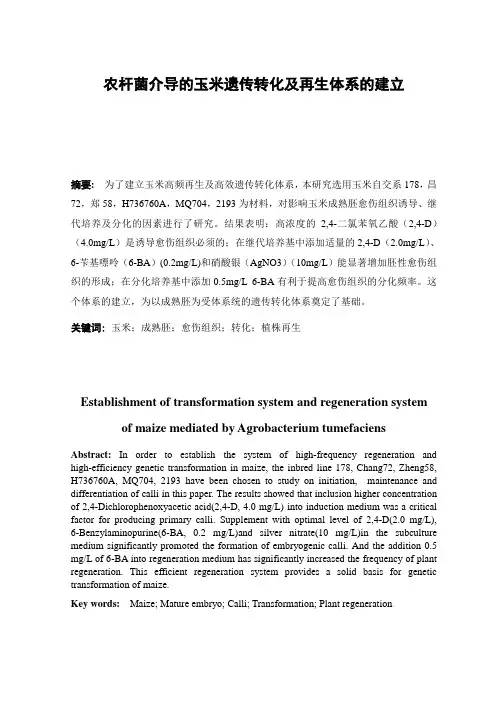
农杆菌介导的玉米遗传转化及再生体系的建立摘要:为了建立玉米高频再生及高效遗传转化体系,本研究选用玉米自交系178,昌72,郑58,H736760A,MQ704,2193为材料,对影响玉米成熟胚愈伤组织诱导、继代培养及分化的因素进行了研究。
结果表明:高浓度的2,4-二氯苯氧乙酸(2,4-D)(4.0mg/L)是诱导愈伤组织必须的;在继代培养基中添加适量的2,4-D(2.0mg/L)、6-苄基嘌呤(6-BA)(0.2mg/L)和硝酸银(AgNO3)(10mg/L)能显著增加胚性愈伤组织的形成;在分化培养基中添加0.5mg/L 6-BA有利于提高愈伤组织的分化频率。
这个体系的建立,为以成熟胚为受体系统的遗传转化体系奠定了基础。
关键词:玉米;成熟胚;愈伤组织;转化;植株再生Establishment of transformation system and regeneration system of maize mediated by Agrobacterium tumefaciens Abstract: In order to establish the system of high-frequency regeneration and high-efficiency genetic transformation in maize, the inbred line 178, Chang72, Zheng58, H736760A, MQ704, 2193 have been chosen to study on initiation, maintenance and differentiation of calli in this paper. The results showed that inclusion higher concentration of 2,4-Dichlorophenoxyacetic acid(2,4-D, 4.0 mg/L) into induction medium was a critical factor for producing primary calli. Supplement with optimal level of 2,4-D(2.0 mg/L), 6-Benzylaminopurine(6-BA, 0.2 mg/L)and silver nitrate(10 mg/L)in the subculture medium significantly promoted the formation of embryogenic calli. And the addition 0.5 mg/L of 6-BA into regeneration medium has significantly increased the frequency of plant regeneration. This efficient regeneration system provides a solid basis for genetic transformation of maize.Key words: Maize; Mature embryo; Calli; Transformation; Plant regeneration摘要ABSTRACT目录1序言 (4)2玉米再生及基因转化体系的研究 (4)2.1玉米再生体系的发展历程 (4)2.2玉米再生及基因转化体系的材料选择 (4)2.3玉米再生体系的影响因素 (4)2.4玉米遗传转化的发展过程 (5)2.5玉米遗传转化方法 (6)2.5.1 电激法 (6)2.5.2 花粉管通道法 (7)2.5.3 PEG法 (7)2.5.4 基因枪法 (7)2.5.5农杆菌介导法 (8)2.6玉米再生及遗传转化的常用受体 (9)2.6.1愈伤组织再生系统 (9)2.6.2原生质体再生系统 (9)2.6.3种质系统 (9)2.6.4直接分化再生系统 (9)2.7本实验研究内容 (10)3玉米成熟胚再生体系的建立 (11)3.1材料与方法 (11)3.1.1 材料 (11)3.1.2实验方法 (11)3.1.2.1 外植体的选择与预培养 (11)3.1.2.2愈伤组织的诱导 (11)3.1.2.2 胚性愈伤组织的形成及愈伤组织的继代 (12)3.2结果与分析 (12)3.2.1玉米种子的预培养 (12)3.2.2愈伤组织的诱导 (13)3.2.3 胚性愈伤组织的形成 (15)3.2.4 AgNO3对胚性愈伤组织形成的影响 (15)3.2.5愈伤组织的分化 (15)3.3 结论与讨论 (16)4 农杆菌介导的玉米转化体系的建立 (18)4.1材料与方法 (18)4.1.1 材料 (18)4.1.2 培养基配制 (18)4.1.3转化方法 (19)4.1.3.1 侵染液的准备 (19)4.1.3.2 侵染 (19)4.1.3.3 抗性愈伤的筛选 (19)4.2 结果与分析 (19)5 参考文献 (22)6致谢 (24)附录 (25)1序言玉米是早熟禾科(Poaceae)玉蜀黍族(Maydeae)一年生谷类植物,学名Zea mays,起源于北、中、南美洲。
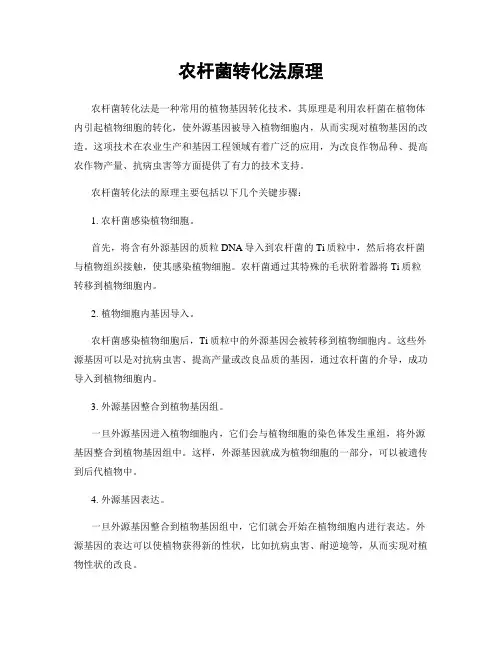
农杆菌转化法原理农杆菌转化法是一种常用的植物基因转化技术,其原理是利用农杆菌在植物体内引起植物细胞的转化,使外源基因被导入植物细胞内,从而实现对植物基因的改造。
这项技术在农业生产和基因工程领域有着广泛的应用,为改良作物品种、提高农作物产量、抗病虫害等方面提供了有力的技术支持。
农杆菌转化法的原理主要包括以下几个关键步骤:1. 农杆菌感染植物细胞。
首先,将含有外源基因的质粒DNA导入到农杆菌的Ti质粒中,然后将农杆菌与植物组织接触,使其感染植物细胞。
农杆菌通过其特殊的毛状附着器将Ti质粒转移到植物细胞内。
2. 植物细胞内基因导入。
农杆菌感染植物细胞后,Ti质粒中的外源基因会被转移到植物细胞内。
这些外源基因可以是对抗病虫害、提高产量或改良品质的基因,通过农杆菌的介导,成功导入到植物细胞内。
3. 外源基因整合到植物基因组。
一旦外源基因进入植物细胞内,它们会与植物细胞的染色体发生重组,将外源基因整合到植物基因组中。
这样,外源基因就成为植物细胞的一部分,可以被遗传到后代植物中。
4. 外源基因表达。
一旦外源基因整合到植物基因组中,它们就会开始在植物细胞内进行表达。
外源基因的表达可以使植物获得新的性状,比如抗病虫害、耐逆境等,从而实现对植物性状的改良。
农杆菌转化法的原理简单清晰,通过这种方法可以实现对植物基因的改造,为农业生产提供了重要的技术手段。
在实际应用中,农杆菌转化法已经成功应用于多种作物,如水稻、小麦、玉米、大豆等,为作物的抗病虫害、耐逆境等性状的改良提供了有效途径。
总的来说,农杆菌转化法作为一种重要的植物基因转化技术,其原理清晰,操作简单,成功率高,因此在农业生产和基因工程领域有着广泛的应用前景。
随着技术的不断进步和完善,相信农杆菌转化法将会为农业生产和作物改良带来更多的机遇和挑战。
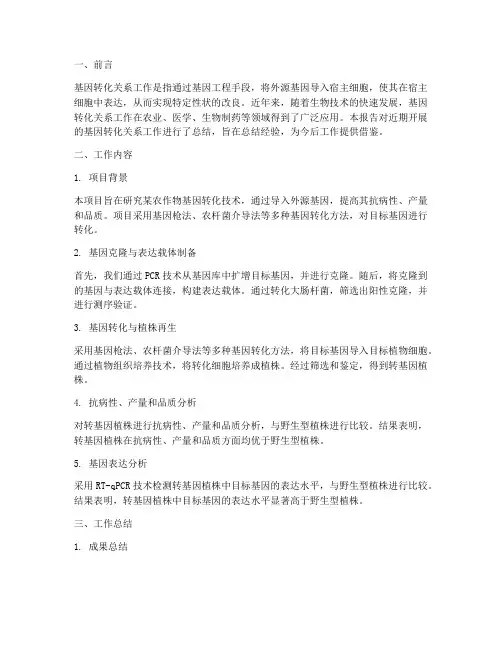
一、前言基因转化关系工作是指通过基因工程手段,将外源基因导入宿主细胞,使其在宿主细胞中表达,从而实现特定性状的改良。
近年来,随着生物技术的快速发展,基因转化关系工作在农业、医学、生物制药等领域得到了广泛应用。
本报告对近期开展的基因转化关系工作进行了总结,旨在总结经验,为今后工作提供借鉴。
二、工作内容1. 项目背景本项目旨在研究某农作物基因转化技术,通过导入外源基因,提高其抗病性、产量和品质。
项目采用基因枪法、农杆菌介导法等多种基因转化方法,对目标基因进行转化。
2. 基因克隆与表达载体制备首先,我们通过PCR技术从基因库中扩增目标基因,并进行克隆。
随后,将克隆到的基因与表达载体连接,构建表达载体。
通过转化大肠杆菌,筛选出阳性克隆,并进行测序验证。
3. 基因转化与植株再生采用基因枪法、农杆菌介导法等多种基因转化方法,将目标基因导入目标植物细胞。
通过植物组织培养技术,将转化细胞培养成植株。
经过筛选和鉴定,得到转基因植株。
4. 抗病性、产量和品质分析对转基因植株进行抗病性、产量和品质分析,与野生型植株进行比较。
结果表明,转基因植株在抗病性、产量和品质方面均优于野生型植株。
5. 基因表达分析采用RT-qPCR技术检测转基因植株中目标基因的表达水平,与野生型植株进行比较。
结果表明,转基因植株中目标基因的表达水平显著高于野生型植株。
三、工作总结1. 成果总结本项目成功将目标基因导入目标植物细胞,并得到转基因植株。
通过抗病性、产量和品质分析,证实了转基因植株在抗病性、产量和品质方面均优于野生型植株。
此外,基因表达分析表明,转基因植株中目标基因的表达水平显著高于野生型植株。
2. 经验总结(1)优化基因转化方法,提高转化效率。
(2)优化植物组织培养技术,提高植株再生率。
(3)加强抗病性、产量和品质分析,为基因转化工作提供有力支持。
(4)注重基因表达分析,为基因转化工作提供科学依据。
四、展望1. 进一步优化基因转化技术,提高转化效率。
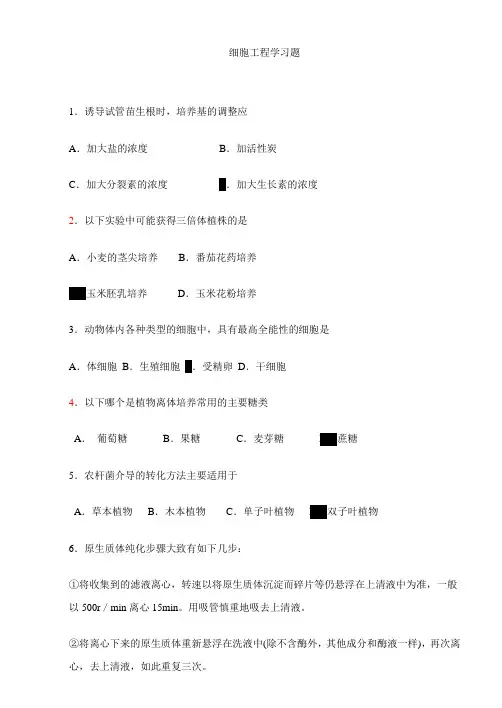
细胞工程学习题1.诱导试管苗生根时,培养基的调整应A.加大盐的浓度B.加活性炭C.加大分裂素的浓度D.加大生长素的浓度2.以下实验中可能获得三倍体植株的是A.小麦的茎尖培养B.番茄花药培养C.玉米胚乳培养D.玉米花粉培养3.动物体内各种类型的细胞中,具有最高全能性的细胞是A.体细胞B.生殖细胞C.受精卵D.干细胞4.以下哪个是植物离体培养常用的主要糖类A.葡萄糖B.果糖C.麦芽糖D.蔗糖5.农杆菌介导的转化方法主要适用于A.草本植物B.木本植物C.单子叶植物D.双子叶植物6.原生质体纯化步骤大致有如下几步:①将收集到的滤液离心,转速以将原生质体沉淀而碎片等仍悬浮在上清液中为准,一般以500r/min离心15min。
用吸管慎重地吸去上清液。
②将离心下来的原生质体重新悬浮在洗液中(除不含酶外,其他成分和酶液一样),再次离心,去上清液,如此重复三次。
③将原生质体混合液经筛孔大小为40~100um的滤网过滤,以除去未消化的细胞团块和筛管、导管等杂质,收集滤液。
④用培养基清洗一次,最后用培养基将原生质调到一定密度进展培养。
一般原生质体的培养密度为104~106/ml。
正确的操作步骤是:〔〕A ①②③④B②③①④C③①②④D③②①④7.常用的细胞融合剂是A.刀豆球蛋白B.聚乙二醇〔PEG〕C.细胞松弛素B D.脂质体8.利用细胞杂交瘤技术制备单克隆抗体过程中,HAT培养基用来进展A.细胞融合B.杂交瘤选择C.检测抗体D.动物免疫9.以下过程中,没有发生膜融合的是A.植物体细胞杂交B.受精过程C.氧进入细胞中的线粒体D.单克隆抗体的产生10.科学家用小鼠骨髓瘤细胞与某种细胞融合,得到杂交细胞,经培养可产生大量的单克隆抗体。
与骨髓瘤细胞融合的是A.经过免疫的B细胞B.没经过免疫的T细胞C.经过免疫的T淋巴细胞D.没经过免疫的B淋巴细胞二填空题1、在植物组织培养基中,添加_____细胞分裂素_____ 能促进合成细胞分裂素,有利于细胞的分裂与分化,促进芽的形成2、在植物组织培养基中,添加_____肌醇_____ 能促进糖类物质的转化,也能促进愈伤组织的生长以及胚状体的形成3、生长素是由__色氨酸_____通过一系列中间产物形成,在植物组织培养中生长素主要是用来刺激细胞的分裂和诱导根的分化,吲哚乙酸〔IAA〕、2、4-二氯苯养乙酸〔2、4-D〕、吲哚乙酸〔IAA〕、萘乙酸(NAA)、吲哚丁酸〔IBA〕等为类生长素。
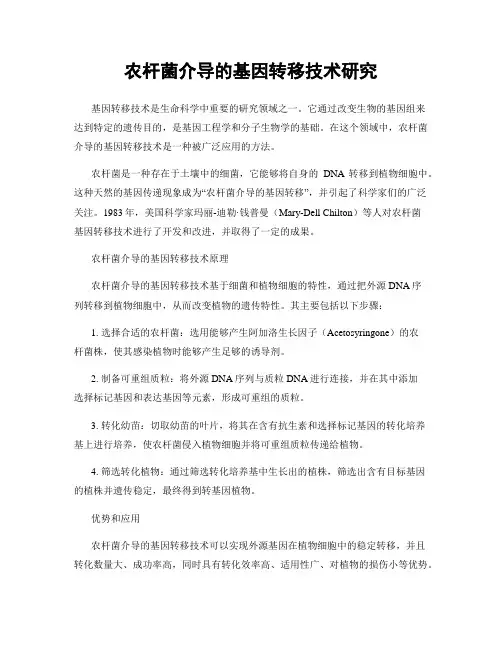
农杆菌介导的基因转移技术研究基因转移技术是生命科学中重要的研究领域之一。
它通过改变生物的基因组来达到特定的遗传目的,是基因工程学和分子生物学的基础。
在这个领域中,农杆菌介导的基因转移技术是一种被广泛应用的方法。
农杆菌是一种存在于土壤中的细菌,它能够将自身的DNA转移到植物细胞中。
这种天然的基因传递现象成为“农杆菌介导的基因转移”,并引起了科学家们的广泛关注。
1983年,美国科学家玛丽-迪勒·钱普曼(Mary-Dell Chilton)等人对农杆菌基因转移技术进行了开发和改进,并取得了一定的成果。
农杆菌介导的基因转移技术原理农杆菌介导的基因转移技术基于细菌和植物细胞的特性,通过把外源DNA序列转移到植物细胞中,从而改变植物的遗传特性。
其主要包括以下步骤:1. 选择合适的农杆菌:选用能够产生阿加洛生长因子(Acetosyringone)的农杆菌株,使其感染植物时能够产生足够的诱导剂。
2. 制备可重组质粒:将外源DNA序列与质粒DNA进行连接,并在其中添加选择标记基因和表达基因等元素,形成可重组的质粒。
3. 转化幼苗:切取幼苗的叶片,将其在含有抗生素和选择标记基因的转化培养基上进行培养,使农杆菌侵入植物细胞并将可重组质粒传递给植物。
4. 筛选转化植物:通过筛选转化培养基中生长出的植株,筛选出含有目标基因的植株并遗传稳定,最终得到转基因植物。
优势和应用农杆菌介导的基因转移技术可以实现外源基因在植物细胞中的稳定转移,并且转化数量大、成功率高,同时具有转化效率高、适用性广、对植物的损伤小等优势。
因此,农杆菌介导的基因转移技术被广泛应用于农业、药物、生物燃料等领域中,为人类生产和经济发展做出了重要贡献。
在农业领域,农杆菌介导的基因转移技术可以应用于粮食、蔬菜、水果等作物的改良和栽培,增加产量、改善品质、提高抗病性等;在药物领域,它可以用于药用植物的生产和基因组编辑,进而形成新的制药或疗法;在生物燃料领域,计划利用农杆菌介导的基因转移技术改良木质素的生产,提高油脂等生物质的产量。
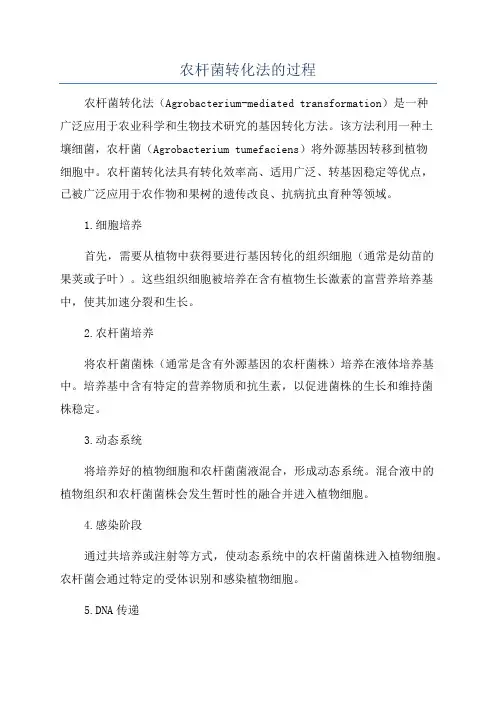
农杆菌转化法的过程农杆菌转化法(Agrobacterium-mediated transformation)是一种广泛应用于农业科学和生物技术研究的基因转化方法。
该方法利用一种土壤细菌,农杆菌(Agrobacterium tumefaciens)将外源基因转移到植物细胞中。
农杆菌转化法具有转化效率高、适用广泛、转基因稳定等优点,已被广泛应用于农作物和果树的遗传改良、抗病抗虫育种等领域。
1.细胞培养首先,需要从植物中获得要进行基因转化的组织细胞(通常是幼苗的果荚或子叶)。
这些组织细胞被培养在含有植物生长激素的富营养培养基中,使其加速分裂和生长。
2.农杆菌培养将农杆菌菌株(通常是含有外源基因的农杆菌株)培养在液体培养基中。
培养基中含有特定的营养物质和抗生素,以促进菌株的生长和维持菌株稳定。
3.动态系统将培养好的植物细胞和农杆菌菌液混合,形成动态系统。
混合液中的植物组织和农杆菌菌株会发生暂时性的融合并进入植物细胞。
4.感染阶段通过共培养或注射等方式,使动态系统中的农杆菌菌株进入植物细胞。
农杆菌会通过特定的受体识别和感染植物细胞。
5.DNA传递一旦农杆菌菌株感染了植物细胞,它会将其含有外源基因的DNA片段传递给植物细胞。
这个DNA片段通常是携带目标基因和选择标记基因的载体。
选择标记基因可以使得转化后的植物细胞在包含选择抗生素的培养基上存活。
6.培养和筛选转化后的植物细胞被转移到含有选择抗生素的培养基中,使得只有携带外源基因的细胞可以生长和分裂。
这样就可以筛选出带有目标基因的转化植物细胞。
7.植株再生将筛选出的转化细胞培养到适当的大小和形态后,再将其转移到含有特定激素的培养基中,以促使其分化为整个植株。
经过适当的培养和生长,就可以获得转基因植物。
总结来说,农杆菌转化法通过将植物细胞和农杆菌菌株进行共培养,使农杆菌将外源基因传递到植物细胞中,然后通过筛选和培养,最终获得转基因植物。
这种方法在农业科学和生物技术研究中具有广泛的应用前景。
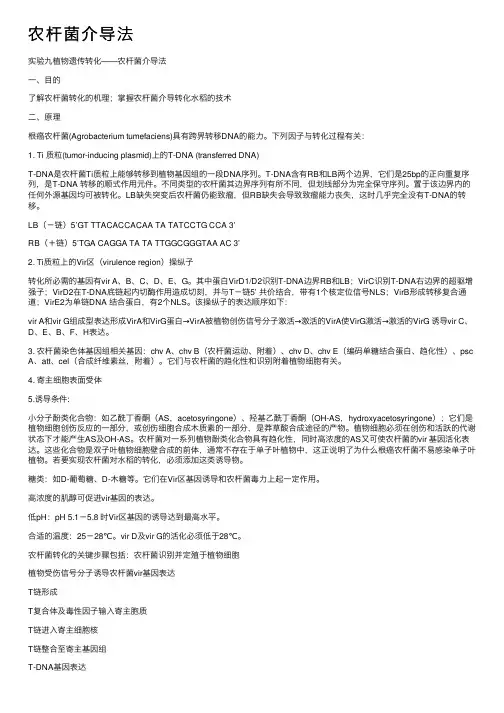
农杆菌介导法实验九植物遗传转化——农杆菌介导法⼀、⽬的了解农杆菌转化的机理;掌握农杆菌介导转化⽔稻的技术⼆、原理根癌农杆菌(Agrobacterium tumefaciens)具有跨界转移DNA的能⼒。
下列因⼦与转化过程有关:1. Ti 质粒(tumor-inducing plasmid)上的T-DNA (transferred DNA)T-DNA是农杆菌Ti质粒上能够转移到植物基因组的⼀段DNA序列。
T-DNA含有RB和LB两个边界,它们是25bp的正向重复序列,是T-DNA 转移的顺式作⽤元件。
不同类型的农杆菌其边界序列有所不同,但划线部分为完全保守序列。
置于该边界内的任何外源基因均可被转化。
LB缺失突变后农杆菌仍能致瘤,但RB缺失会导致致瘤能⼒丧失,这时⼏乎完全没有T-DNA的转移。
LB(-链)5’GT TTACACCACAA TA TATCCTG CCA 3’RB(+链)5’TGA CAGGA TA TA TTGGCGGGTAA AC 3’2. Ti质粒上的Vir区(virulence region)操纵⼦转化所必需的基因有vir A、B、C、D、E、G。
其中蛋⽩VirD1/D2识别T-DNA边界RB和LB;VirC识别T-DNA右边界的超驱增强⼦;VirD2在T-DNA底链起内切酶作⽤造成切刻,并与T-链5’ 共价结合,带有1个核定位信号NLS;VirB形成转移复合通道;VirE2为单链DNA 结合蛋⽩,有2个NLS。
该操纵⼦的表达顺序如下:vir A和vir G组成型表达形成VirA和VirG蛋⽩→VirA被植物创伤信号分⼦激活→激活的VirA使VirG激活→激活的VirG 诱导vir C、D、E、B、F、H表达。
3. 农杆菌染⾊体基因组相关基因:chv A、chv B(农杆菌运动、附着)、chv D、chv E(编码单糖结合蛋⽩、趋化性)、pscA、att、cel(合成纤维素丝,附着)。
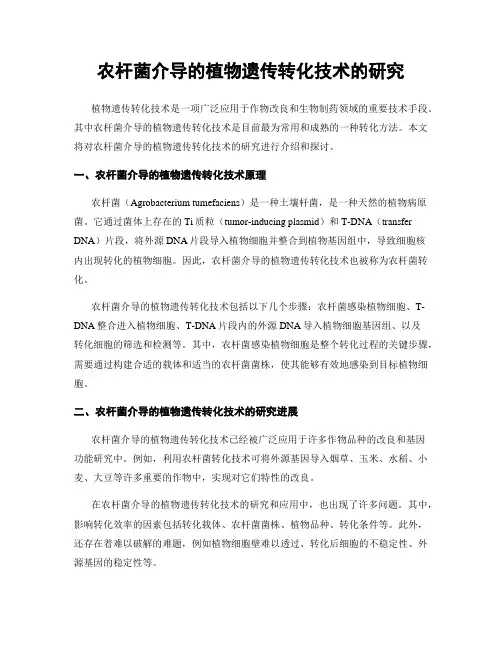
农杆菌介导的植物遗传转化技术的研究植物遗传转化技术是一项广泛应用于作物改良和生物制药领域的重要技术手段。
其中农杆菌介导的植物遗传转化技术是目前最为常用和成熟的一种转化方法。
本文将对农杆菌介导的植物遗传转化技术的研究进行介绍和探讨。
一、农杆菌介导的植物遗传转化技术原理农杆菌(Agrobacterium tumefaciens)是一种土壤杆菌,是一种天然的植物病原菌。
它通过菌体上存在的Ti质粒(tumor-inducing plasmid)和T-DNA(transfer DNA)片段,将外源DNA片段导入植物细胞并整合到植物基因组中,导致细胞核内出现转化的植物细胞。
因此,农杆菌介导的植物遗传转化技术也被称为农杆菌转化。
农杆菌介导的植物遗传转化技术包括以下几个步骤:农杆菌感染植物细胞、T-DNA整合进入植物细胞、T-DNA片段内的外源DNA导入植物细胞基因组、以及转化细胞的筛选和检测等。
其中,农杆菌感染植物细胞是整个转化过程的关键步骤,需要通过构建合适的载体和适当的农杆菌菌株,使其能够有效地感染到目标植物细胞。
二、农杆菌介导的植物遗传转化技术的研究进展农杆菌介导的植物遗传转化技术已经被广泛应用于许多作物品种的改良和基因功能研究中。
例如,利用农杆菌转化技术可将外源基因导入烟草、玉米、水稻、小麦、大豆等许多重要的作物中,实现对它们特性的改良。
在农杆菌介导的植物遗传转化技术的研究和应用中,也出现了许多问题。
其中,影响转化效率的因素包括转化载体、农杆菌菌株、植物品种、转化条件等。
此外,还存在着难以破解的难题,例如植物细胞壁难以透过、转化后细胞的不稳定性、外源基因的稳定性等。
为了提高转化效率和成功率,许多研究者着眼于改进农杆菌转化系统,包括构建新的载体、筛选适合的农杆菌菌株、研究植物细胞壁和农杆菌感染机制等。
一些新型转化技术,例如粒子轰击法、激光微加工技术和等离子膜处理技术等,也被尝试用于植物遗传转化中,但它们还需要进一步的研究和优化。
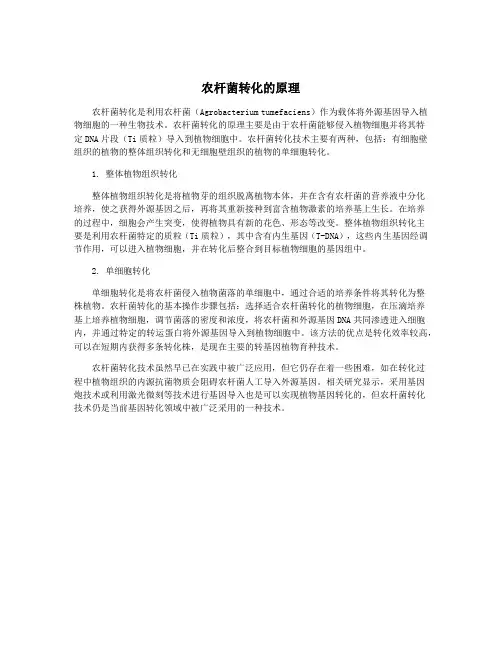
农杆菌转化的原理农杆菌转化是利用农杆菌(Agrobacterium tumefaciens)作为载体将外源基因导入植物细胞的一种生物技术。
农杆菌转化的原理主要是由于农杆菌能够侵入植物细胞并将其特定DNA片段(Ti质粒)导入到植物细胞中。
农杆菌转化技术主要有两种,包括:有细胞壁组织的植物的整体组织转化和无细胞壁组织的植物的单细胞转化。
1. 整体植物组织转化整体植物组织转化是将植物芽的组织脱离植物本体,并在含有农杆菌的营养液中分化培养,使之获得外源基因之后,再将其重新接种到富含植物激素的培养基上生长。
在培养的过程中,细胞会产生突变,使得植物具有新的花色、形态等改变。
整体植物组织转化主要是利用农杆菌特定的质粒(Ti质粒),其中含有内生基因(T-DNA),这些内生基因经调节作用,可以进入植物细胞,并在转化后整合到目标植物细胞的基因组中。
2. 单细胞转化单细胞转化是将农杆菌侵入植物菌落的单细胞中,通过合适的培养条件将其转化为整株植物。
农杆菌转化的基本操作步骤包括:选择适合农杆菌转化的植物细胞,在压滴培养基上培养植物细胞,调节菌落的密度和浓度,将农杆菌和外源基因DNA共同渗透进入细胞内,并通过特定的转运蛋白将外源基因导入到植物细胞中。
该方法的优点是转化效率较高,可以在短期内获得多条转化株,是现在主要的转基因植物育种技术。
农杆菌转化技术虽然早已在实践中被广泛应用,但它仍存在着一些困难,如在转化过程中植物组织的内源抗菌物质会阻碍农杆菌人工导入外源基因。
相关研究显示,采用基因炮技术或利用激光微刻等技术进行基因导入也是可以实现植物基因转化的,但农杆菌转化技术仍是当前基因转化领域中被广泛采用的一种技术。
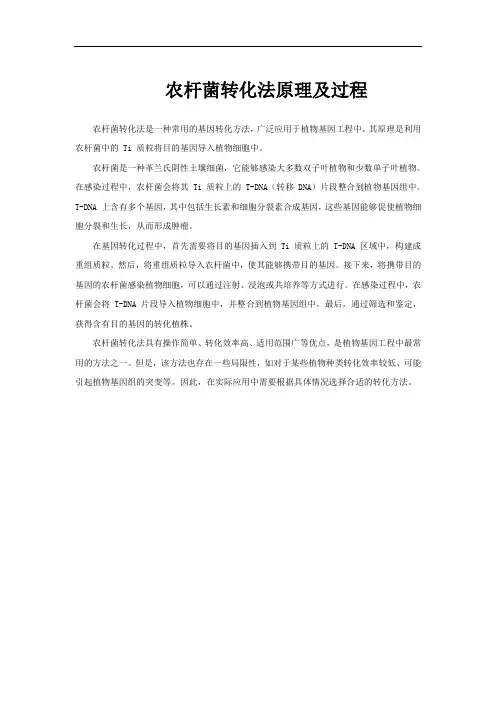
农杆菌转化法原理及过程
农杆菌转化法是一种常用的基因转化方法,广泛应用于植物基因工程中。
其原理是利用农杆菌中的 Ti 质粒将目的基因导入植物细胞中。
农杆菌是一种革兰氏阴性土壤细菌,它能够感染大多数双子叶植物和少数单子叶植物。
在感染过程中,农杆菌会将其 Ti 质粒上的 T-DNA(转移 DNA)片段整合到植物基因组中。
T-DNA 上含有多个基因,其中包括生长素和细胞分裂素合成基因,这些基因能够促使植物细胞分裂和生长,从而形成肿瘤。
在基因转化过程中,首先需要将目的基因插入到 Ti 质粒上的 T-DNA 区域中,构建成重组质粒。
然后,将重组质粒导入农杆菌中,使其能够携带目的基因。
接下来,将携带目的基因的农杆菌感染植物细胞,可以通过注射、浸泡或共培养等方式进行。
在感染过程中,农杆菌会将 T-DNA 片段导入植物细胞中,并整合到植物基因组中。
最后,通过筛选和鉴定,获得含有目的基因的转化植株。
农杆菌转化法具有操作简单、转化效率高、适用范围广等优点,是植物基因工程中最常用的方法之一。
但是,该方法也存在一些局限性,如对于某些植物种类转化效率较低、可能引起植物基因组的突变等。
因此,在实际应用中需要根据具体情况选择合适的转化方法。
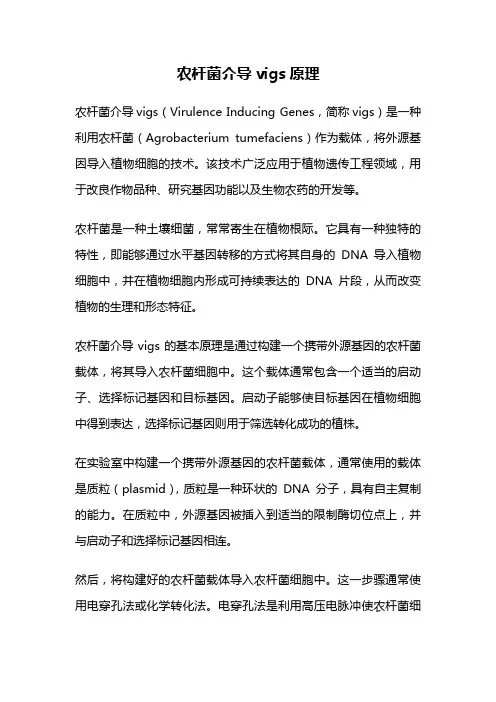
农杆菌介导vigs原理农杆菌介导vigs(Virulence Inducing Genes,简称vigs)是一种利用农杆菌(Agrobacterium tumefaciens)作为载体,将外源基因导入植物细胞的技术。
该技术广泛应用于植物遗传工程领域,用于改良作物品种、研究基因功能以及生物农药的开发等。
农杆菌是一种土壤细菌,常常寄生在植物根际。
它具有一种独特的特性,即能够通过水平基因转移的方式将其自身的DNA导入植物细胞中,并在植物细胞内形成可持续表达的DNA片段,从而改变植物的生理和形态特征。
农杆菌介导vigs的基本原理是通过构建一个携带外源基因的农杆菌载体,将其导入农杆菌细胞中。
这个载体通常包含一个适当的启动子、选择标记基因和目标基因。
启动子能够使目标基因在植物细胞中得到表达,选择标记基因则用于筛选转化成功的植株。
在实验室中构建一个携带外源基因的农杆菌载体,通常使用的载体是质粒(plasmid),质粒是一种环状的DNA分子,具有自主复制的能力。
在质粒中,外源基因被插入到适当的限制酶切位点上,并与启动子和选择标记基因相连。
然后,将构建好的农杆菌载体导入农杆菌细胞中。
这一步骤通常使用电穿孔法或化学转化法。
电穿孔法是利用高压电脉冲使农杆菌细胞膜发生短暂的孔洞,从而使载体能够进入细胞。
化学转化法则是利用高浓度的钙离子和胺基酸改变细胞膜的通透性,使载体能够进入细胞。
接下来,将转化成功的农杆菌细胞与待转化的植物组织接触。
这种接触通常是通过切割植物组织的方法进行,例如切割叶片、茎段或种子等。
当农杆菌细胞与植物组织接触时,它会释放出一种称为激发物(virulence inducing factor)的信号分子,该信号分子能够刺激植物细胞生成伤口愈合所需的激素。
农杆菌细胞通过这个伤口进入植物细胞内部,并释放其携带的农杆菌载体。
载体中的外源基因会被植物细胞质体接收,并在细胞内形成可持续表达的DNA片段。
这样,外源基因就能够在植物细胞中发挥作用,例如产生某种特定的蛋白质、调控植物生长发育或提高植物的抗病性等。
农杆菌转化法单子叶植物农杆菌转化法是一种常用的植物遗传转化技术,它是利用土壤中普遍存在的一种生物——农杆菌的特殊细胞质遗传机制来实现将外源基因导入植物细胞内的方法。
这种技术不但可以用来转化双子叶植物,而且在单子叶植物中也得到了广泛的应用。
单子叶植物是指种子植物的一类,其胚种子由一个种皮、一对子叶和一个胚根组成,与双子叶植物不同。
单子叶植物在农业生产中占有重要地位,例如水稻、小麦、玉米等。
在进行单子叶植物的农杆菌转化时,需要充分考虑其特殊的生理与生物学特点。
一般来说,在进行单子叶植物的农杆菌转化前,我们需要先获得相应的植物组织(例如愈伤组织、幼胚等)和合适的农杆菌菌株,并进行预处理。
预处理的目的是为了让菌株和植物细胞更好地结合,提高转化率。
预处理方法可以根据不同的单子叶植物特点进行调整,例如水稻的处理时间较长,需要进行10-15天的预处理;而小麦则只需要进行1-2天的处理。
在预处理完成后,需要将待转化的外源基因DNA与农杆菌载体进行连接,并将其导入到菌株中。
具体的操作可以通过化学转化、电转化或热激转化等多种方法来实现。
这些方法的选择与实际情况有关,需要在实践中根据不同的物种和实验条件进行选择。
转化后的农杆菌菌株需要进行筛选和评估,以确认外源基因已经成功地导入了植物细胞内,并且被稳定地集成到了细胞核中。
评估方法可以通过PCR检测、Southern blotting、Northern blotting、Western blotting等方法来实现。
这些方法主要是对转化植株的基因型和表达水平进行分析,以确保外源基因已经集成到植物细胞内,并且能够正常表达。
农杆菌转化法在单子叶植物中的应用不仅可以进行基础研究,还可以用于农业生产中的性状改良和优良品种选育。
例如,我们可以通过外源基因的导入来实现对一些逆境生存能力的增强,如抗病、耐旱、抗盐碱等。
此外,这种技术还可以用于挖掘植物自身天然的次生代谢产物和活性成分,以改善产品的质量和营养价值。
农杆菌介导转化方法农杆菌介导转化方法是一种常用的基因转化技术,广泛应用于植物、微生物等领域。
本文将介绍农杆菌介导转化方法的原理、步骤和应用。
一、原理农杆菌介导转化方法是利用农杆菌(Agrobacterium tumefaciens)作为载体,将外源基因导入目标细胞中的一种方法。
农杆菌是一种自然界广泛存在的土壤细菌,它能将其自身的DNA转移到植物细胞中,从而导致植物发生病理性变化。
利用这一特性,科学家将目标基因插入到农杆菌的载体DNA中,通过农杆菌的感染作用,将目标基因导入到目标细胞中。
二、步骤农杆菌介导转化方法通常包括以下几个步骤:1. 农杆菌培养:首先需要将含有目标基因的农杆菌培养至适宜的生长期,以保证其感染能力。
2. 植物处理:将目标植物的组织经过表面消毒处理,然后将其切割成小片或小块,以增加接触面积。
3. 农杆菌感染:将培养好的农杆菌与植物组织接触,使其感染植物细胞。
通常使用浸泡法或注射法进行感染。
4. 抗生素筛选:在感染后的组织中加入适当浓度的抗生素,以筛选转化成功的细胞。
只有携带目标基因的细胞才能够存活下来。
5. 培养和再生:将筛选出的转化细胞进行培养和再生,形成转基因植株。
三、应用农杆菌介导转化方法已成功应用于多种植物和微生物中,具有以下几个优点:1. 高效性:农杆菌介导转化方法可以在较短时间内实现大量基因转化,且转化效率较高。
2. 转基因稳定性:通过农杆菌介导转化方法获得的转基因植株通常具有较高的遗传稳定性,能够稳定地传递给下一代。
3. 广泛适用性:农杆菌介导转化方法适用于多种植物和微生物,包括农作物、果树、花卉等。
可以用于改良作物的品种、抗病性、耐逆性等性状。
4. 无需种子:与传统的植物遗传改良方法相比,农杆菌介导转化方法无需使用种子,能够直接利用植物的组织进行转化,节约了时间和资源。
5. 无需外界辅助:农杆菌介导转化方法不需要借助特殊设备或昂贵试剂,只需在实验室条件下进行即可。
农杆菌介导的转化作用原理
农杆菌介导的转化是一种生物技术方法,用于将外源DNA引入植物细胞中。
其原理是利用农杆菌生长势旺盛、易于培养的特点,将目标外源DNA导入到农杆菌的质粒中,形成重组质粒。
然后通过将转化质粒与植物细胞接触,使其外源DNA传递到植物细胞内部。
具体步骤如下:
1. 构建重组质粒:在质粒中插入目标外源DNA,通常使用限制性内切酶将目标基因插入到质粒的多克隆位点(多克隆位点是一段DNA序列,能够容纳外源DNA)。
2. 转化农杆菌:将质粒导入到农杆菌中,使其质粒与细菌细胞融合,形成重组菌株。
3. 培养菌株:培养重组菌株,使其扩增到大量细胞。
4. 处理植物组织:将希望转化的植物组织(例如幼嫩的叶片或胚)与农杆菌接触,使农杆菌与植物细胞发生互作用。
5. 重组质粒转入植物细胞:通过机械方法(例如悬浮培养)或生理方法(例如创伤诱导),使农杆菌穿过植物细胞的细胞壁,使重组质粒进入植物细胞。
6. 重组质粒在植物细胞中复制和表达:重组质粒在植物细胞中复制,并将插入的目标基因转录和翻译为蛋白质。
通过农杆菌介导的转化方法,可以有效地将外源基因导入到植物细胞中,实现基
因转移和基因表达的目的。
这种方法在植物基因工程和转基因技术中得到广泛应用。
2023年高考生物模拟试卷注意事项:1.答卷前,考生务必将自己的姓名、准考证号填写在答题卡上。
2.回答选择题时,选出每小题答案后,用铅笔把答题卡上对应题目的答案标号涂黑,如需改动,用橡皮擦干净后,再选涂其它答案标号。
回答非选择题时,将答案写在答题卡上,写在本试卷上无效。
3.考试结束后,将本试卷和答题卡一并交回。
一、选择题:(共6小题,每小题6分,共36分。
每小题只有一个选项符合题目要求)1.玉米幼苗尖端被切除后,切面放一含生长素的琼脂块,给予单侧光,如图所示。
一段时间后,幼苗将()A.向左弯曲生长B.向右弯曲生长C.向上直立生长D.停止生长2.利用装置甲,在相同条件下分别将绿色植物E、F的叶片制成大小相同的“圆叶”,抽出空气,进行光合作用速率测定。
图乙是利用装置甲测得的数据绘制成的坐标图。
下列叙述正确的是()A.从图乙可看出,F植物适合在较强光照下生长B.光照强度为1klx,装置甲中放置植物F叶片进行测定时,液滴向右移动C.光照强度为3klx时,E、F两种植物的叶片合成有机物的速率之比为3:2D.光照强度为6klx时,装置甲中E植物叶片比F植物叶片浮到液面所需时间长3.小花碱茅属于禾本科草本植物,种子外包被颖壳。
研究人员以小花碱茅成熟种子为外植体,对种子进行脱颖处理,用不同浓度激素配比诱导愈伤组织形成及再分化,成功建立了完整的小花碱茅组织培养植株再生体系,以下是部分研究数据,下列说法正确的是()A.6-BA会抑制愈伤组织形成,浓度越高抑制作用越强B.脱分化形成愈伤组织时,可避光条件下无菌培养C.可以用高压蒸汽灭菌法对脱颖种子进行无菌处理D.对种子进行脱颖处理的目的是防止颖壳污染环境4.切除健康狗的胰脏,2天后狗出现糖尿病的一切症状。
随后连续给其注射一定量溶于生理盐水的胰岛素,发现其血糖含量恢复正常。
由此推测:胰岛素能降低血糖的含量。
为了证明这一推论,你认为下列最适宜作为对照组的是A.既不切除健康狗的胰脏,又不注射胰岛素B.用溶解于蒸馏水的胰岛素溶液进行注射C.切除健康狗体内的胰脏2天后,只注射等量的生理盐水D.将健康狗体内摘除的胰脏制成提取液,注射给切除胰脏的狗5.下列有关性别决定与伴性遗传的叙述(不考虑突变),正确的是A.性染色体上的基因都与性别决定有关B.性染色体上基因的遗传遵循自由组合定律C.伴X染色体隐性遗传病,人群中女患者远远多于男患者D.伴X染色体显性遗传病,男患者的女儿均患病,男患者的儿子可能患病6.为研究细胞分裂素的生理作用,研究者将菜豆幼苗制成的插条插入蒸馏水中如图甲,对插条的处理方法及结果如图乙,下列叙述正确的是()A.实验自变量是用细胞分裂素分别处理A、B叶片B.插条制备时一定要需要剪去根系和幼芽,减少内源激素的影响C.在实验I中,对A叶进行实验处理,导致B叶生长抑制,对照组不作处理D.实验II、III、IV的结果表明,B叶的生长与A叶的关系是A叶数量越多,B叶生长越慢二、综合题:本大题共4小题7.(9分)研究发现,癌细胞表面的PD-L1蛋白可与T细胞表面的PD-1蛋白结合,导致T细胞不能全面启动对癌细胞的免疫攻击,而使用抗PD-l抗体可使癌症患者的肿瘤快速萎缩,这种治疗方法叫做癌症免疫疗法。
GENETIC TRANSFORMATION AND HYBRIDIZATIONAgrobacterium -mediated transformation of embryogenic cultures and plant regeneration in Vitis rotundifolia Michx.(muscadine grape)S.A.Dhekney ÆZ.T.Li ÆM.Dutt ÆD.J.GrayReceived:6November 2007/Revised:10January 2008/Accepted:18January 2008/Published online:7February 2008ÓSpringer-Verlag 2008Abstract A method to produce transgenic plants of Vitis rotundifolia was developed.Embryogenic cultures were initiated from leaves of in vitro grown shoot cultures and used as target tissues for Agrobacterium -mediated genetic transformation.A green fluorescent protein/neomycin phosphotransferase II (gfp/nptII )fusion gene that allowed for simultaneous selection of transgenic cells based on GFP fluorescence and kanamycin resistance was used to optimize parameters influencing genetic transformation.It was determined that both proembryonal masses (PEM)and mid-cotyledonary stage somatic embryos (SE)were suitable target tissues for co-cultivation with Agrobacterium as evi-denced by transient GFP expression.Kanamycin at 100mg l -1in the culture medium was effective in sup-pression of non-transformed tissue and permitting the growth and development of transgenic cells,compared to 50or 75mg l -1,which permitted the proliferation of more non-transformed cells.Transgenic plants of ‘‘Alachua’’and ‘‘Carlos’’were recovered after secondary somatic embryo-genesis from primary SE explants co-cultivated with Agrobacterium .The presence and stable integration of transgenes in transgenic plants was confirmed by PCR andSouthern blot hybridization.Transgenic plants exhibited uniform GFP expression in cells of all plant tissues and organs including leaves,stems,roots,inflorescences and the embryo and endosperm of developing berries.Keywords Genetic engineering ÁGrapevine ÁSomatic embryos ÁTransgenic Abbreviations BA BenzyladenineGFP Green fluorescent protein NAA Napthyleneacetic acidIntroductionVitis rotundifolia Michx.the muscadine grape,is native to the southeastern United States where it is cultivated for fresh fruit,jelly,juice and wine production.It is an excellent source of health beneficial compounds (Percival and Sims 2003).Wine produced from V.rotundifolia contains 10–12times more resveratrol than that produced from V.vinifera L.(Ector et al.1996).Morphologically,V.rotundifolia differs significantly from V.vinifera (Olien 2001).The stem of V.rotundifolia has a smooth and thin bark that exfoliates in scales from older branches.Tendrils are unbranched.Berries are borne in small clusters of two to ten and possess a distinct fruity flavor.In contrast,the stem of V.vinifera has a rough bark that exfoliates in strips from older branches.Tendrils are forked and berries are borne in large clusters.V.rotundifolia possesses a greater degree of tolerance to pest and diseases and performs better in the hot and humid conditions of the southeastern US coastal plains (Galet and Norton 1990).Communicated by K.Kamo.S.A.Dhekney ÁZ.T.Li ÁM.Dutt ÁD.J.Gray (&)Mid-Florida Research and Education Center,University of Florida/IFAS,2725Binion Road,Apopka,FL 32703-8504,USA e-mail:djg@ufl.eduPresent Address:M.DuttCitrus Research and Education Center,University of Florida/IFAS,700Experiment Station Road,Lake Alfred,FL 33850,USAPlant Cell Rep (2008)27:865–872DOI 10.1007/s00299-008-0512-2Although conventional breeding has resulted in improved varieties of V.rotundifolia(Fry1967),they still possess undesirable berry characteristics such as thick skin, large number of seeds and poor storage life(Himelrick 2003).Transfer of certain traits,such as seedlessness,from V.vinifera to V.rotundifolia could lead to varieties with improved fruit qualities.However,the development of hybrids between V.vinifera(2n=38)and V.rotundifolia (2n=40)is hampered due to marginal sexual compati-bility between the two species,which is attributed primarily to the difference in chromosome number(Patel and Olmo1955).Low yield in F1hybrids of interspecific crosses greatly restricts the transfer of desirable traits between the two species.Crop improvement in V.rotundifolia might be achieved using genetic transformation to facilitate transfer of desirable traits,such as seedlessness,from V.vinifera (Colova-Tsolova et al.2003,2005).In addition,genetic transformation will allow identification and isolation of novel disease resistance genes from V.rotundifolia utiliz-ing reverse genetics as previously reported for Arabidopsis (Sessions et al.2002).Agrobacterium-mediated transformation is routinely used to produce transgenic plants from V.vinifera and a number of Vitis species and hybrids(reviewed by Gray et al.2005); however,to date,there have been no reports describing the procedure for V.rotundifolia.Somatic embryogenesis and plant regeneration was previously reported in V.rotundifolia (Colova-Tsolova et al.2007;Gray1992;Gray and Hanger 1993;Robacker1993),suggesting that embryogenic cultures might be used in genetic transformation as in earlier studies with V.vinifera(Li et al.2001,2006).We present here thefirst report of transgenic plant recovery from V.rotundifolia,which was achieved by Agrobacterium-mediated transformation of embryogenic cultures.We studied factors,including the developmental stage of embryogenic cultures amenable to transformation and kanamycin sensitivity of embryogenic cultures to recover transgenic plants from V.rotundifolia‘‘Alachua’’. Materials and methodsEmbryogenic culture initiation and maintenanceEmbryogenic culture induction medium consisted of Nitsch and Nitsch(1969)salts and vitamins,0.1g l-1 myo-inositol,20g l-1sucrose,9l M2,4-D and4.4l M BA.Medium pH was adjusted to5.5prior to the addition of 7.0g l-1TC agar(Phytotechnology laboratories,LLC, Shawnee Mission,KS,USA).The medium was autoclaved at120°C and 1.1kg cm2for20min,and then25ml medium was dispensed into each100915mm Petri dish and allowed to cool.In vitro shoot cultures of V.rotundi-folia‘‘Alachua’’were prepared as described by Gray and Benton(1991)for use as explants.Unopened in vitro grown leaves1.5–5.0mm long were placed abaxial surface down,on induction medium and incubated in dark at26°C for5–7weeks.Resulting callus cultures were transferred to basal MS medium lacking glycine and containing10.7l M NAA and0.9l M BA and maintained at26°C in light (65l m s-1m-1)for5weeks.Developing embryogenic cultures were transferred to growth regulator free X6 medium consisting of a modified MS medium lacking glycine and supplemented with 3.033g l-1KNO3and 0.364g l-1NH4Cl(as the sole nitrogen source),60.0g l-1 sucrose,1.0g l-1myo-inositol,7.0g l-1TC agar(Phyto-technology laboratories,LLC,Shawnee Mission,KS, USA),0.5g l-1activated charcoal and a pH value adjusted to5.8prior to autoclaving.Cultures were maintained by careful transfer of proliferating proembryonal masses (PEM)to fresh X6medium at4–6weeks interval.Proembryonal masses growing on X6medium were used to initiate suspension cultures as previously described for other Vitis species(Jayasankar et al.1999).The liquid medium was composed of B5major salts(Gamborg et al. 1968),MS minor salts and organic compounds,400mg l-1 glutamine,60g l-1sucrose and4.5l M2,4-D.The pH was adjusted to5.8prior to dispensing35ml into each 125ml Erlenmeyerflask,which was sealed with aluminum foil and autoclaved as before.Flasks were inoculated with 0.5g of PEM and several layers of Parafilm were used to seal the aluminum foil cover to theflask.Cultures were maintained in the light at26°C on a rotary shaker at 110rpm and subcultured every2weeks.Cultures were passed through a900l m sieve to separate the developing somatic embryos(SE)from thefine fraction of PEM. Sieving was carried out whenever necessary to remove developing SE and synchronize culture development.PEM were used for co-cultivation with Agrobacterium or trans-ferred to X6medium for SE development;these SE were also used in transformation experiments. Transformation vector and bacterial strainA bifunctional marker gene consisting of an in-frame translational fusion between an egfp gene and a neomycin phosphotransferase(nptII)gene(Li et al.2001)was placed under the control of a double Cassava Vein Mosaic Virus (CsVMV)promoter and cloned into the T-DNA region of a pBIN-19derived binary vector(Datla et al.1991).The binary vector(designated as pLC214)was introduced into A.tumefaciens strain EHA105by the freeze–thaw method (Burrow et al.1990).The Agrobacterium culture was grown overnight in MG/L medium(Garfinkle and Nester1980)at26°C on a rotary shaker (185rpm)containing 20mg l -1rifampicin and 100mg l -1kanamycin.Prior to transfor-mation,the bacterial cells were pelleted by centrifugation at 6,000rpm for 8min,resuspended in 25ml liquid X2medium (same as X6medium but with 20g l -1sucrose)without any antibiotics and cultured continuously under the same conditions for 4h.The bacterial culture (OD 600=0.8–1.0)then was used to inoculate embryogenic cultures.Transformation of embryogenic culturesCultures composed of either PEM (Fig.1a)or mid-cotyle-donary stage SE (Fig.1b)were co-cultivated with Agrobacterium to determine the earliest stage of develop-ment amenable to transformation.A typical mid-cotyledonary stage SE is shown in Fig.1b (inset).Wounding of cultures during co-cultivation was avoided to reduce subsequent post-co-cultivation necrosis.Cultures were submerged in bacterial solution for 8min and then blotted dry on filter paper to remove excess bacterial solution.They were subsequently placed in Petri dishes on two layers of filter paper soaked in liquid DM medium (Li et al.2001).Cultures were co-cultivated in the dark for 3days at 26°C.GFP expression in PEM and SE was recorded using a Leica MZFLIII stereomicroscope equipped for epi-fluorescence (Leica Microscopy System Ltd.,Heerbrugg,Switzerland).Percent transient GFP expression was recorded as the number of PEM or SE exhibiting GFP versus the total number of explants co-cultivated with Agrobacterium .A PEM or SE with ten or more GFP expressing cells was scored as positive for transient expression.Effect of kanamycin on growth and proliferation of embryogenic culturesIn order to optimize the selection of stably transformed callus and transgenic SE,kanamycin at three concentrations(50,75and 100mg l -1)was tested in DM medium (Li et al.2001).SE at the mid-cotyledonary stage were co-cultivated with Agrobacterium for 3days as described above.SE then were washed for 3days by transfer to 125ml Erlenmeyer flasks containing 30ml liquid DMcck 15medium (DM medium containing 200mg l -1each of carbenicillin and cefotaxime,and 15mg l -1kanamycin)on a rotary shaker at 110rpm.Washed SE were transferred to Petri dishes containing 25ml solidified DMcck 50,DMcck 75or DMcck 100medium (DM medium containing 200mg l -1each of carbenicillin and cefotaxime and either 50,75or 100mg l -1kanamycin).Thirty SE were placed in each Petri dish,which was replicated three times for each kanamycin concentration.Developing cultures were grown in the dark for 90days.Cultures then were trans-ferred to X6cck 50,X6cck 75or X6cck 100medium (X6medium containing 200mg l -1each of carbenicillin and cefotaxime and either 50,75or 100g l -1of kana-mycin)and subcultured at 30days intervals until secondary SE were observed.Experiments were repeated three times.Analysis of stable transgene expression at different kanamycin concentrationsStable transformation frequency was estimated based on the number of SE explants producing a GFP positive callus (transgenic callus line)versus the total number of co-cul-tivated primary SE explants.GFP positive SE that developed from a GFP positive callus were isolated and designated as an independent transgenic SE line.The number of transgenic callus lines were recorded after 60days on DMcck 50,DMcck 75and DMcck 100medium while the number of transgenic SE lines and non-trans-formed SE (SE which did not express GFP)were recorded after transfer to X6cck 50,X6cck 75and X6cck 100medium,respectively.Fig.1Embryogenic cultures of V.rotundifolia ‘‘Alachua’’used for transformation.aProembryonal masses (PEM)and b Somatic embryos (SE)at the mid-cotyledonary stage of development.Note A single mid-cotyledonary stage SE (inset ).Scale bars Fig.a ,b =10mm,Fig.b inset =0.5mm.Transgenic plant recoveryFive embryos from each independent transgenic SE line were transferred to germination medium,which consisted of MS salts lacking CaCl2and supplemented with709mg l-1 Ca(NO3)2Á4H2O,0.845mg l-1MnSO4ÁH2O, 1.0g l-1 myo-inositol,1.0l M BA and7g l-1T.C.agar.Cultures were placed for6weeks in light(65l mol s-1m-1)with a 16h photoperiod.Plants with a shoot and root system were acclimatized to ex-vitro conditions in a growth chamber and then transferred to a greenhouse.Tissues and organs from transgenic plants were observed for GFP expression and compared with non-transformed plants,which emitted chlorophyll induced red autofluorescence.Molecular analysis of transgenic plant linesTotal genomic DNA was isolated from young leaves of three transgenic plant lines and a non-transformed plant according to the method of Lodhi et al.(1994),but modified with increased EDTA(100mM)in extraction buffer.PCR was performed to detect specific DNA sequences in transgenic plants that corresponded to the egfp/nptII fusion gene.A forward primer EG-51(50-ATG GTGAGCAAGGGCGAGGAGCTGT-30)and a reverse primer EG-32(50-CTTGTACAGCTCGTCCATGCCG AGA-30)were used to amplify a717bp DNA fragment from the egfp/nptII fusion gene.Conditions for PCR reactions were:1cycle at95°C for4min,39cycles at 94°C for1min,58°C for1min,72°C for1min and a final cycle at72°C for4min.Plasmid DNA used in transformation served as a positive control while DNA from non-transformed plants was used as a negative control.Southern blot hybridization was performed as previ-ously described(Li et al.1997).Three microgram of DNA was digested with Hin dIII,separated by electro-phoresis in a0.7%(w/v)agarose gel,and transferred onto a nylon membrane(Schleicher and Schuell,Inc., Keene,NH,USA).A717bp DNA fragment corre-sponding to the egfp gene was labeled with digoxigenin and used as a probe for hybridization according to the manufacturer’s instructions(Roche Molecular Biochemi-cals,Mannheim,Germany).The hybridized membrane was washed,subjected to chemilluminescent development using CDP-Star substrate,and then exposed tofilm (Kodak Biomax Light1).A molecular marker was con-structed using egfp containing plasmid fragments of known sizes and used as a positive control while geno-mic DNA from a non-transformed plant served as a negative control.Statistical analysisExperimental results were analyzed using one way analysis of variance(ANOVA)and Student’s t-test to determine mean separation between treatments.ResultsProliferation of embryogenic culturesProembryonal masses proliferation occurred in liquid medium.Sieving led to synchronous development of cul-tures.However,maintenance in liquid medium beyond 12weeks led to browning of cultures,even with biweekly transfers and when cell density was lowered.Cultures could be maintained by transferring PEM to solid X6 medium,which also was used for development of SE.To date,embryogenic cultures grown on solid medium have been maintained for17months by transfer of small PEM to fresh medium every6weeks.Transformation of embryogenic cultures Proembryonal masses and SE were amenable to transfor-mation by Agrobacterium.Transient GFP expression occurred in PEM and SE3–5days after co-cultivation (Fig.2a),then gradually decreased in intensity.Fifty-eight percent of SE exhibited transient GFP expression(data not shown).Severe tissue necrosis occurred after co-cultivation as evidenced by culture browning.GFP-positive callus began to appear from co-cultivated explants after30days of culture on DMcck50,DMcck75and DMcck100 medium.Callus proliferation occurred for approximately 60days before transgenic PEM began to appear(Fig.2b). PEM gave rise to transgenic SE30days after transfer to X6cck50,X6cck75and X6cck100medium(Fig.2c).Effect of kanamycin concentration on growthand development of embryogenic culturesPreliminary experiments compared the effect of kanamycin levels on the number of stable transgenic SE lines recov-ered from PEM and SE explants.No differences in response were observed between PEM and SE;therefore only data for the later are presented(Table1).SE explants on DMcck50medium exhibited rapid growth of both transgenic and non-transgenic callus as judged by GFP expression;this resulted in a20%recovery of transgenic callus(Table1).Similarly62%of the secondary SEultimately recovered from this treatment were non-trans-genic.In contrast,kanamycin at 75and 100mg l -1suppressed growth of non-transgenic callus and SE while permitting the proliferation of transgenic cells.There were no significant differences between the number of trans-genic SE lines due to 75mg l -1(43.3%)or 100mg l -1kanamycin (39%).However,100mg l -1kanamycin resulted in significantly fewer non-transgenic SE (14.4%),compared to 75mg l -1(31.1%).Transgenic somatic embryo germination and plant developmentEighty-eight percent of transgenic SE germinated as evi-denced by development of pigmentation,enlargement of the hypocotyl,expansion of cotyledons and emergence of the radicle.Resulting plants appeared to be true to type (Fig.2d).A total of 21transgenic plant lines were obtained from 72embryo lines.Green fluorescence was observed from cells of all mature plant tissues and organs includingleaves (Fig.2e),stems,roots (data not shown),inflores-cences (Fig.2f),and anthers (Fig.2g).GFP expression was not observed in the exocarp or mesocarp tissues of devel-oping berries (Fig.2h).Developing seeds exhibited GFP expression in the endosperm and embryo (Fig.2h),but not the hardening seed coat (data not shown).Molecular analysis of transformantsGenomic DNA was extracted from three transgenic plant lines and used for amplification of the egfp gene.Ampli-fication of a 717bp fragment corresponding to the egfp gene following PCR was observed in all three transgenic lines (Fig.3,lanes 1–3)and the positive plasmid control (Fig.3,lane P),whereas no amplification was observed from the non-transformed plant line (Fig.3,lane 4).Genomic DNA from three randomly selected transgenic plant lines and a non-transformed plant was digested with restriction endonuclease Hin dIII and analyzed for trans-gene integration and copy number using SouthernblotFig.2Production of transgenic plants of V.rotundifolia ‘‘Alachua’’.a Transient GFP expression in SE explants4days after co-cultivation with Agrobacterium .b GFPexpressing transgenic callus and PEM 60days after co-cultivation.c Transgenicsecondary SE expressing GFP 90days after co-cultivation.d A true to type transgenic ‘‘Alachua’’plant in the greenhouse.Uniform GFP expression in mature leaf (e ),inflorescence (f )and anthers (g ).h GFP expression in developing berry.Note that the berryexocarp and mesocarp,which is devoid of GFP,emits red chlorophyll-inducedautofluorescence whereas the embryo and endosperm show uniform GFP expression.Scale bars :Fig.a ,f ,g ,h =0.5mm,Fig.b ,c ,e =5mmhybridization.The presence of a single Hin dIII restriction site upstream of the probe sequence within the T-DNA region of pLC214ensured that any hybridization fragments produced were due to a downstream Hin dIII restriction site in the plant genome and subsequently corresponded to the number of integrated T-DNA sequences.Digested genomic DNA samples along with the molecular marker were subjected to hybridization using a 717bp DNA fragment corresponding to the egfp gene.No hybridization was observed in the non-transformed control plant (Fig.4,lane 1).Transgenic plant AL214-1(Fig.4,lane 2)showed a single hybridization fragment (6.0kb)whereas AL214-3(Fig.4,lane 4)showed two hybridization fragments (6.0and 11.42kb),thereby indicating the insertion of one and two transgenes,respectively.The transgenic plant AL214-2(Fig.4,lane 3)produced three hybridization fragments (2.72,3.97and 6.0kb)indicating the insertion of multiple transgenes.Among these DNA fragments,ahybridization signal of greater intensity (corresponding to approx.five copies of the plasmid fragment)was observed in the 6.0kb fragment.DiscussionThis is the first report of genetic transformation and plant regeneration from V.rotundifolia .The egfp/nptII reporter-marker fusion gene facilitated study and optimization of the transformation process.Both PEM and SE were determined to be suitable targets for Agrobacterium infection as indi-cated by transient GFP expression.Proliferation of embryogenic cultures in V.rotundifolia occurs by division and fragmentation of PEM (Gray 1992),which give rise to SE (Gray and Mortensen 1987;Jayasankar et al.2003).Thus,transformation of PEM cells can result in formation of transgenic SE lines and subsequently plants.The use of suspension cultures facilitated rapid proliferation of embryogenic tissue,thereby generating a large amount of material for transformation experiments in a short time.PEM were used previously for genetic transformation of V.vinifera (Mauro et al.1995;Vidal et al.2003).Similarly,we have demonstrated that SE are suitable targets for transformation (Li et al.2001).Proliferation of grapevine SETable 1Effect of kanamycin concentration on growth and recovery of stably transformed V.rotundifolia ‘‘Alachua’’callus,SE lines and non-transformed SE after co-cultivation with Agrobacterium Kanamycin conc.(mg l -1)Transgenic callus lines (%)Transgenic SE lines (%)Non-transformed SE (%)5020.0c 16.6b 62.0a 7551.0a 43.3a 31.1b 10044.0b39.0a14.4cEach treatment consisted of 30SE explants in a Petri dish containingDMcck medium,which was replicated three times.Values represent mean percentage of observations from three replications for each treatment.Data were recorded 60days (transgenic callus)and 90days (transgenic and non-transformed SE)after co-cultivation.Statistical analysis was carried out using one-way ANOVA.Mean within columns followed by the same letter were not significantly different according to Student’s t test (P =0.05)Fig.4Southern hybridization analysis of genomic DNA isolated from leaves of a non-transformed plant and three randomly selected independent transgenic plant lines of V.rotundifolia ‘‘Alachua’’.Three micro gram genomic DNA from plants was digested with restriction enzyme Hin dIII and separated by electrophoresis on a 0.7%(w/v)agarose gel along with plasmid fragments as a molecular marker (M ).A film image showing varying size and copy numbers of integrated egfp transgenes from digested genomic DNA of a non-transformed plant (lane 1),transgenic plants AL214-1,AL214-2,AL214-3(lanes 2–4)and the control molecular marker (M).Fig.3PCR analysis of genomic DNA isolated from leaves of non-transformed and transgenic V.rotundifolia ‘‘Alachua’’plants.A 717bp DNA fragment corresponding to the egfp gene sequence was amplified from three randomly selected transgenic plants (lanes 1–3)and a control plasmid (P )but not from a non-transformed plant (lane 4)occurs via secondary embryogenesis with secondary embryos arising from single epidermal or sub-epidermal cells(Gray1995).Such cells represent suitable targets for transformation and plant recovery via the process of sec-ondary somatic embryogenesis in V.rotundifolia as well.The egfp gene permitted visual screening of cultures for identifying transformants while the nptII gene allowed for optimum concentrations of kanamycin to be determined. Kanamycin at50mg l-1was not effective since it allowed non-transformed callus and SE proliferation and resulted in recovery of relatively fewer transformants.In comparison, 100mg l-1kanamycin suppressed non-transformed tissue and allowed greater percentage of transformed SE and transgenic plants to be recovered.This kanamycin level is higher than that used by Vidal et al.(2003)(15mg l-1) and Li et al.(2006)(75mg l-1)to transform Vitis.Even though a few non-transformed SE developed at100mg l-1 kanamycin,they were easily identified by their lack of GFP emission.Thus,a combination of egfp along with nptII allowed for effective screening of embryogenic cultures and confidence in recovery of stable transformants.Only 21independently transformed plant lines were recovered from72transgenic SE lines.Low plant recovery from SE of V.rotundifolia was previously attributed to the frequent development of large fused cotyledons,which inhibited shoot development(Gray1992).The presence and stable integration of transgenes in the plant genome was confirmed by PCR and Southern blot hybridization.Among the transgenic plants analyzed, insertion of single and multiple copies of transgenes was observed.No visual difference in GFP expression was observed among transgenic plants with varying transgene copy number.Among the three hybridization fragments observed in transgenic plant line AL214-2,greater signal intensity was found to be associated with a6.0kb frag-ment.Since an equal amount of genomic DNA was loaded for all samples during electrophoresis(data not shown),the greater signal intensity observed may have resulted from the integration of transgenes at a single genomic locus as concatamers.The presence of such concatamers has been previously reported in studies using both microprojectile bombardment(Finer and McMullen1990;Hadi et al.1996) and Agrobacteriu m-mediated transformation(Wenck et al. 1997).A high level of GFP expression continued to be observed in this transgenic plant and its clones produced by vegetative propagation,2years after regeneration,thereby indicating no gene silencing due to multiple copy insertions as has been previously discussed(Muskens et al.2000).In addition to the quantitative results reported here for ‘‘Alachua’’,transgenic plants of V.rotundifolia‘‘Carlos’’were recovered as well.Studies are ongoing to extend transformation technology to additional cultivars and begin the testing of functional genes.Acknowledgments This research was supported by the Florida Agricultural Experiment Station and the Florida Department of Agri-culture and Consumer Services’Viticulture Trust Fund.D.J.Gray and Z.T.Li own stock in Florida Genetics LLC,which may license resulting patents and,as such,may benefitfinancially as a result of the outcome of research reported in this publication.ReferencesBurrow MD,Chlan CA,Sen P,Murai N(1990)High frequency generation of transgenic tobacco plants after modified leaf disk cocultivation with Agrobacterium tumefaciens.Plant Mol Biol Rep8:124–139Colova-Tsolova VM,Lu J,Perl A(2003)Cyto-embryological aspects of seedlessness in Vitis vinifera L.and exploiting recombinant DNA technology as an advanced approach for introducing seedlessness into Vinifera and Muscadine grapes.Acta Hortic 603:195–199Colova-Tsolova VM,Lu J,Perl A(2005)Genetically customized seedless grapes for fresh market industry.Acta Hortic689:481–484Colova-Tsolova VM,Bordallo PN,Phills BR,Bausher M(2007) Synchronized somatic embryo development in embryogenic suspensions of grapevine Muscadinia rotundifolia(Michx.) Small.Vitis46:15–18Datla RS,Hammerlindle JK,Pelcher LE,Crosby WL,Selvaraj G (1991)A bifunctional fusion between b-glucuronidase and neomycin phosphotransferase:a broad-spectrum marker enzyme for plants.Gene101:239–246Ector BJ,Magee JB,Hegwood CP,Coigin MJ(1996)Resveratrol concentration in Muscadine berries,juice,pomace,purees,seeds and wine.Am J Enol Vitic47:57–62Finer JJ,McMullen MD(1990)Transformation of cotton(Gossypium hirsutum L.)via particle bombardment.Plant Cell Rep8:586–598Fry BO(1967)Values of certain varieties and selections in breeding high quality,large fruited muscadine grapes.Proc Am Soc Hortic Sci91:213–216Galet P,Norton LT(1990)Introduction:the family Vitaceae and Vitis speciation.In:Pearson RC,Goheen AC(ed)Compendium of grape diseases.APS Press,St.Paul,pp2–3Gamborg OL,Miller RA,Ojima K(1968)Nutrient requirement of suspension cultures of soybean root cells.Exp Cell Res50:151–158 Garfinkle M,Nester EJ(1980)Agrobacterium tumefaciens mutants affected in crown gall tumorigenesis and octopine catabolism J.Bacteriology144:732–743Gray DJ(1992)Somatic embryogenesis and plant regeneration from immature zygotic embryos of muscadine grape(Vitis rotundifo-lia)cultivars.Am J Bot79:542–546Gray DJ(1995)Somatic embryogenesis in grape.In:Jain SM,Gupta PK,Newton RJ(eds)Somatic embryogenesis in woody plants, vol2.Kluwer Academic Publishers,Dordrecht,pp191–217 Gray DJ,Benton CM(1991)In vitro micropropagation and plant establishment of muscadine grape cultivars(Vitis rotundifolia).Plant Cell Tissue Organ Cult27:7–14Gray DJ,Hanger LA(1993)Effect of ovule maturity on recovery of zygotic embryos and embryogenic cultures from muscadine grapes.HortScience28:227Gray DJ,Mortensen JA(1987)Initiation and maintenance of long term somatic embryogenesis from anthers and ovaries of Vitis longii‘Microsperma’.Plant Cell Tissue Organ Cult9:73–80 Gray DJ,Jayasankar S,Li Z(2005)Vitis spp.grape.In:Litz RE(ed) Biotechnology of fruit and nut crops,chap22.Oxford CAB International,Wallingford,pp672–706。